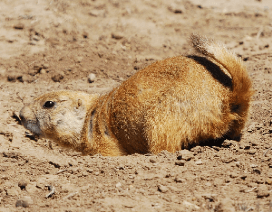
Species
Black-tailed prairie dog (Cynomys ludovicianus); Gunnison’s prairie dog (Cynomys gunnisoni)
Principal Biologist(s)
Dustin Long
Project Location
Vermejo Park Ranch, New Mexico; Bad River Ranches, South Dakota; Z-Bar Ranch, Kansas
Conservation Problem
The range-wide decline of all prairie dog species is attributable to non-native disease—sylvatic plague (Yersinia pestis); loss of habitat and habitat fragmentation; and human persecution (e.g. poisoning and shooting).
Conservation Status
Both the black-tailed and Gunnison’s prairie dogs have been candidate species for listing under the Endangered Species Act. Neither species is currently listed nor afforded any significant state protection in New Mexico, South Dakota, or Kansas.
Project Goals & Objectives
Prairie dogs are a keystone species whose presence on the landscape has a profound positive effect on biodiversity. The primary goal of TESF’s prairie dog restoration project is to provide sufficient habitat to support a stable population of black-footed ferrets. Black-footed ferrets are an endangered obligate predator of prairie dogs that require large, disease-free prairie dog complexes in order to survive.
Project Background
Few species engender as much controversy in the American West as prairie dogs. Many agricultural producers view prairie dogs as competitors for a limited grass resource whose presence represents an immediate threat to their livelihood; conservationists view prairie dogs as a keystone species whose presence on the landscape meets the very specific habitat requirements of numerous imperiled species. The TESF seeks to find that balance where prairie dogs and associated ecological processes and species assemblages can exist in harmony with for-profit endeavors (e.g., bison ranching and big game hunting).
Currently, prairie dogs throughout the American West occupy ~3% of their historical range. This significant loss was largely due to poisoning campaigns in the early and mid-20th century. More recently, the introduced disease sylvatic plague has been the primary range-wide conservation challenge.
Prairie dog restoration on Turner properties began in 1997 with the development of a reliable prairie dog soft-release technique. Using this method, TESF expanded black-tailed prairie dog acreage on the Vermejo Park Ranch in New Mexico from 500 acres to 10,000 acres; the Ash Creek Restoration Area (ACRA) of Bad Rivers Ranches in South Dakota from 125 acres to 1,650 acres; and the Z-Bar in Kansas from 75 acres to 590 acres. Using the same translocation technique, the Gunnison’s prairie dog population at Vermejo has increased from 23 acres to 3,900 acres. In total, prairie dog acreage on Turner properties of which TESF has had oversight grew from 725 acres to a maximum of 16,140 acres by the end of 2011.
